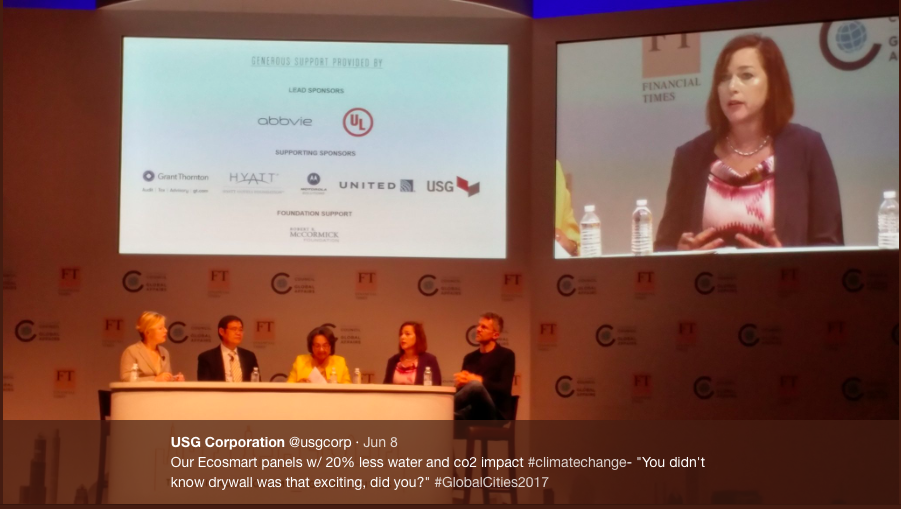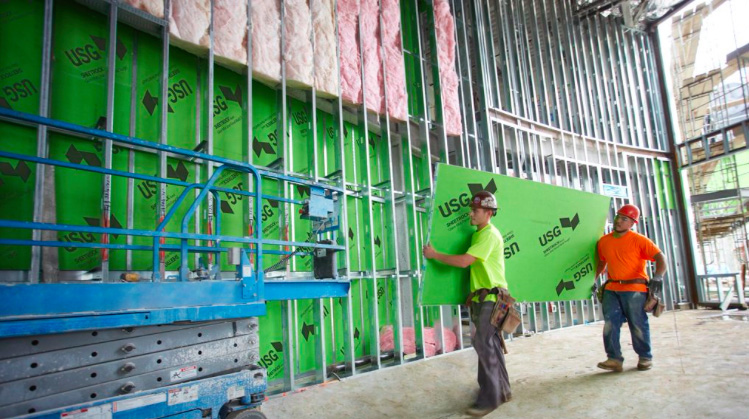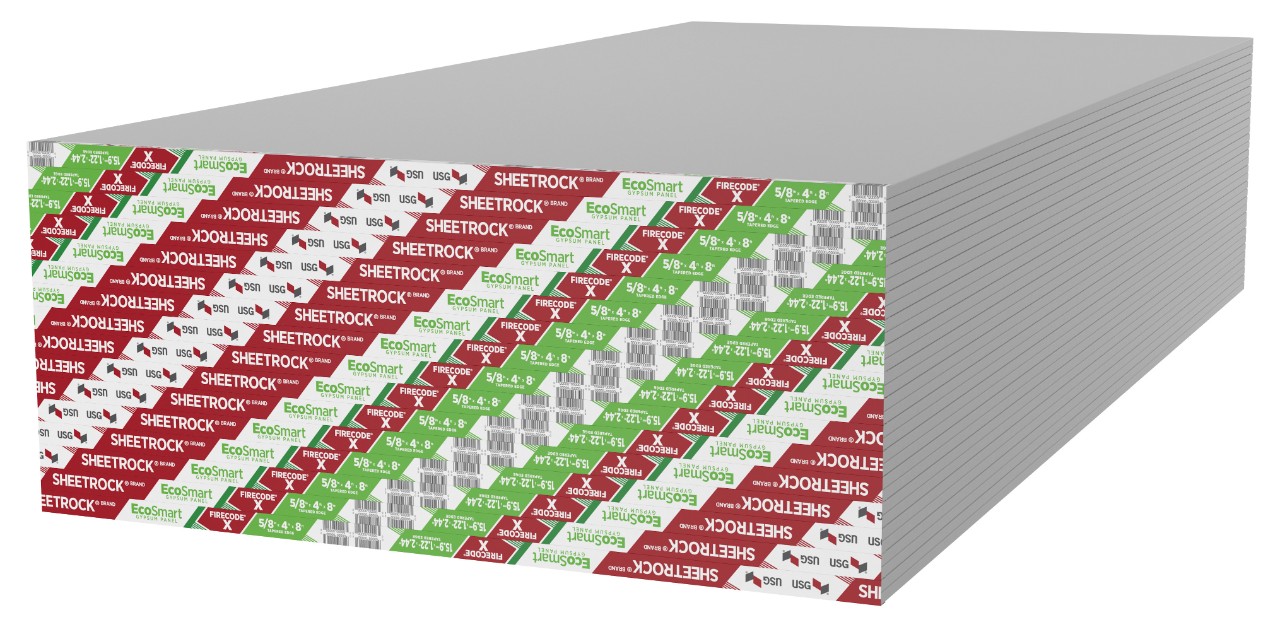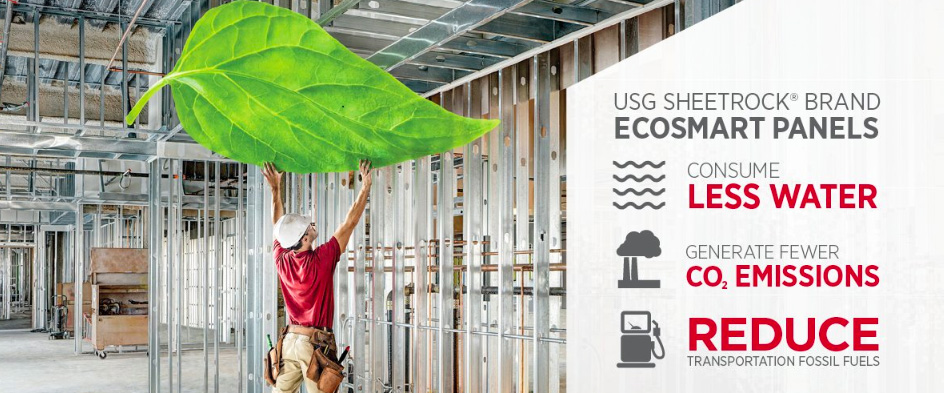
Undeniably, November 2016 was an historically interesting time for an American woman to break through the glass ceiling to become a president. But for Chicago-based USG Corp’s Jennifer Scanlon, the ascension was 15 years in the making.
Scanlon became President and CEO of the 115-year-old building products manufacturer on November 1. At just 49, she is the first female to occupy that corner office in firm history, in an industry long dominated by male voices. But it is Scanlon’s strong international experience and vocal commitment to sustainable practices that have already raised her profile in this, her first year at the helm of a $3-billion multinational.
In June, we had a chance to sit down with Scanlon at the Chicago Council on Global Affairs’ 3rd Annual Global Cities Forum, where she participated on the event’s opening panel, Combating Climate Change. What follows is our subsequent interview…
For BuiltWorlds’s broader coverage of that Cities Forum, click here.
BW: Ms. Scanlon, thanks for your time here. At the recent Cities Forum, you spoke passionately on the issues of addressing climate change and promoting sustainability globally. In light of the US’s recent withdrawal from the Paris Climate Accords, has that altered USG‘s approach to these issues at all? What about the role of the private sector?
Jen Scanlon (JS): Sustainable practices have always been core to USG’s business, and today we are more focused than ever on how we can reduce and reuse waste, work more efficiently and transform manufacturing byproducts into valuable resources to build a better world for our customers, employees and communities. Our customers and our shareholders care about sustainability.
Those of us in the private sector have a responsibility to look at the macro environment that is affecting our business and respond.

The Architecture 2030 Challenge is a great example of how we’re doing this. The initiative was created by a group of leading architects to reduce the carbon emissions of the building process by changing the way things are operated, planned, designed and constructed. The initiative has been adopted worldwide by architecture and planning firms, major developers, and state and local governments. USG was one of the first building product manufacturers to join the challenge, and the first to create products that actually reduce that carbon footprint.
BW: This year marks the 20th year that USG has been a member of U.S. Green Building Council (USGBC). So you joined before it was “cool”, as some might say. Can you speak for a moment about the depth of that commitment and how it started at USG?
JS: USG was committed to being a sustainable company long before it was trendy and certainly long before many of the modern challenges around water and continued CO2 emissions from buildings reached the level they’ve reached today. We were a founding member of USGBC almost 25 years ago and played a significant role in shaping the sustainability-focused practices in the building and construction industry that it established. We assisted in developing what many of you see when you walk into buildings now here in the US: the LEED rating system. That Green Building Rating System, developed in 2000, has become an international standard for environmentally sound buildings.

Our vision as one of the leading manufacturers of building products and innovative solutions around the world is to create products that help reduce not only the amount of CO2 emissions but also the embodied energy used in the building construction sector. That’s really the amount of energy used in the production of materials, the operations of the building, the design of the building and everything else that goes into the life of the building.
BW: The AEC (building) industry long has been perceived to be behind the technology curve. But today, our Buildings 2.0 series chronicles the rapid rise of the Internet of Things (IoT) in our industry, among other advances. How has USG adapted to this wild growth in tech innovations and how has it positioned itself for future growth?

JS: Providing solutions to our customers’ challenges has been the driving force behind USG’s success for 115 years, and we like to think of ourselves as ahead of the curve as we meet the evolving needs of our customers.
We have always focused on harnessing new technologies to create innovative solutions that address our customers’ building challenges and that influence the advancement of the building industry’s standards. Most recently, we introduced USG Sheetrock® Brand EcoSmart Panels – the world’s most sustainable wallboard – to address a growing unmet need of architects around the globe who are looking to use more sustainable products in their structures. Sheetrock® EcoSmart Panels are the first of their kind, and help to reduce the built environment’s carbon footprint through eco-friendly production. They are recognized as the first and only wallboard to meet the rigorous sustainability standards of the global Architecture 2030 Challenge.
Encouraging and rewarding innovation is a key component of USG’s company culture, and we invest smartly in research and development. We have a state-of-the-art Corporate Innovation Center (CIC) located in Illinois, where a team of dedicated experts focus on creating and vigorously testing new products and technologies to ensure that we continue to push the boundaries of design and engineering.

Read our story from last summer on USG’s new pre-treated drywall panels.
In addition to the work being done at our CIC, USG is working in partnership with leading universities and technology companies to explore more ways to advance the built environment. USG has a significant opportunity to reimagine the role building products will play in the years ahead, and we are excited to see the developments that are yet to come.
BW: International work was a focus for you in the years prior to becoming CEO. And raising building standards in the Third World, especially in Asia, is a passion for you. I believe I read that this was, at least in part, inspired by the legendary Fr. Theodore Hesburgh, the longtime president of the University of Notre Dame, your alma mater. That implies a larger vision for USG beyond the bottom line. Can you speak to that?

JS: Yes, Fr. Hesburgh was inspirational in helping me realize that all of us can do more than act in the spaces where we live and work. We should all embrace diversity – no institution becomes great by leaving out any portion of the world’s thinkers. In fact, I keep a book entitled Thanking Father Ted on my bookshelf.
Before becoming President and CEO, I served as president of our international business and helped to create a joint venture with Boral Limited, which we now call USG Boral. Leading that joint venture gave me a perspective on how our technologies are valued around the world, and it has allowed us to have a presence in emerging markets in Asia, Australia, and the Middle East where rapid urbanization is happening. We are working to introduce safer and more efficient building practices and materials to these areas that are still slightly behind the curve.
Manufacturing products that allow for safe building practices around the world is a cause I’m very passionate about. I find it incredibly infuriating to read about a building collapsing in a Third World country — or a fire in a First World country — because local governments ignored the building codes or allowed shortcuts to be made. It puts the people of their community at risk, including the workers and those who live there.
To help combat this problem, we are trying to encourage builders to move away from traditional concrete block construction, and into a steel and cavity wall model that is safer and more efficient. Raising building standards everywhere to avoid similar events is very important to USG.

BW: Finally, since taking this post last fall, you have become one of the most prominent women in a leadership role in the still male-dominated building industry. Do you feel any added responsibility as a pioneer in recruiting more young women into this industry? What do you say to young people, regardless of gender, to inspire them to be builders?

JS: I think a lot about the responsibility and the opportunity of being the CEO of USG. I am conscious of the fact that I serve as a role model for many women but I don’t think about my role that way. My primary focus is on doing right by our customers, our employees, our shareholders and the communities in which we operate. Building a diverse and talented workforce is an essential piece of this strategy and it begins with inspiring and developing the next generation of innovators in STEM (science, technology, engineering and math). My passion for math and chemistry fueled my enthusiasm for USG’s products when I first started working here 15 years ago.
As someone who has found so much fulfillment studying STEM and working for a manufacturing company, I am a big proponent of math, engineering and science education, particularly for women, because it opens up unlimited possibilities for career opportunities. Empowering younger generations to embrace STEM and manufacturing careers is essential for growth in the industry – and is a personal passion for many employees. So together we strive to demonstrate that there are plenty of fulfilling roles in our field.
BW: Ms. Scanlon, thanks again for your time.


Discussion
Be the first to leave a comment.
You must be a member of the BuiltWorlds community to join the discussion.